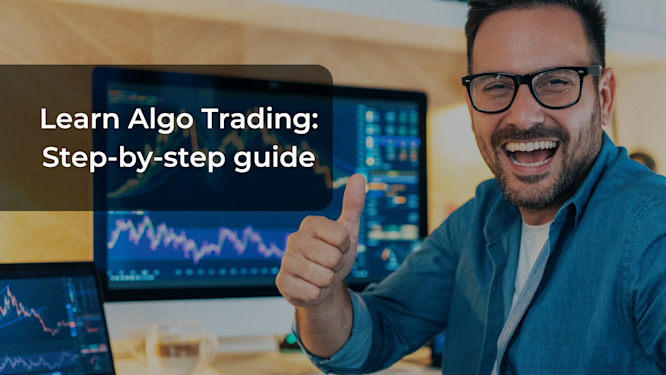Learn Algo Trading - A Comprehensive Guide for Beginners and Professionals
Algo Trading Specifics
Did you know that over 80% of trading volume in developed markets is now driven by algorithmic trading? That’s right—the world of trading has shifted dramatically in recent years, and algo trading is at the forefront of this revolution. By combining data-driven strategies with automation, algo trading is transforming how trades are executed, making them faster, more precise, and less prone to human error. Gone are the days when traders relied solely on intuition and manual processes. Today, technology plays a central role in the financial markets, enabling traders to make split-second decisions based on complex data.
But where do you even start if you want to learn algo trading? Don’t worry, this guide will show you everything you need to know, step by step. Whether you’re a beginner exploring the basics or a professional looking to refine your skills, this is the ultimate resource to help you succeed in the exciting world of algorithmic trading.
(*Source: Market research reports from 2024.)
What is Algo Trading?
Algorithmic trading, or algo trading, is when computers use programs to make trading decisions automatically. It’s a method where computer programs execute trades based on a set of predefined rules. These rules are driven by data, which could include price movements, trading volume, order book dynamics, and other market indicators.
The key advantage of algorithmic trading is that it eliminates human emotion from the trading process. Human traders may act impulsively based on fear or greed, but algorithms simply execute predefined instructions without emotional interference. This ability to automate decisions makes trading faster, more efficient, and less prone to errors, especially during volatile market conditions.
Algo trading also allows for strategies that involve high-frequency, rapid trades that would be impossible for a human trader to execute manually. These algorithms can process vast amounts of data at incredible speeds, making them highly effective in both large institutional environments and retail trading.
Why Learn Algo Trading?
So, why should you dive into algo trading? Here are some compelling reasons why learning algo trading is a game-changer:
Technology is Changing the Game: Financial markets are rapidly adopting technology. The shift toward algo trading is now well underway, and institutions that rely on traditional, manual trading methods are starting to fall behind. Understanding algorithmic trading is crucial for staying ahead in a technology-driven market environment.
Career Opportunities: Algo trading is a booming field in the finance industry. Global banks, hedge funds, asset management firms, and proprietary trading firms are constantly seeking talented individuals to build, test, and implement trading algorithms. Whether you are a quantitative analyst (quant), a programmer, or a data scientist, there’s a growing demand for skilled professionals who can combine financial knowledge with technical expertise.
Efficiency and Precision: Algorithmic trading allows traders to react to market changes within milliseconds. Unlike human traders, who may need several seconds to analyze data and execute trades, algorithms can scan thousands of market conditions in a fraction of a second, helping to seize profitable opportunities and avoid risks.
Risk Management: One of the key features of algorithmic trading is the ability to implement robust risk management strategies. Algorithms can calculate and enforce risk limits in real time, automatically adjusting positions to ensure that the trader's portfolio remains within acceptable risk thresholds. Additionally, algorithmic systems can perform continuous rebalancing of portfolios based on predefined rules, helping to optimize asset allocation.
Whether you’re a novice or an experienced trader, learning algo trading can give you a competitive edge in the fast-evolving world of finance.
Key Concepts to Learn Algo Trading
Before diving into building trading algorithms, it’s essential to understand several foundational concepts. These concepts will form the backbone of your journey into the world of algorithmic trading.
1. Financial Market Basics
To effectively engage in algo trading, you need to understand the underlying market structures and instruments. This includes gaining knowledge of various financial instruments like stocks, options, bonds, and forex (foreign exchange). You should also familiarize yourself with the types of markets (e.g., stock exchanges, over-the-counter markets, etc.) and how they function.
Common trading strategies used in algorithmic trading include:
Trend Following: This strategy aims to capitalize on an existing market trend. When the price of an asset is moving in a consistent direction (either up or down), the algorithm will take positions that follow that trend.
Mean Reversion: This strategy is based on the premise that prices tend to revert to their historical average over time. If an asset’s price deviates significantly from its mean, the algorithm will enter a position expecting the price to revert.
Arbitrage: This strategy takes advantage of price discrepancies between different markets or instruments. For example, if a stock is priced differently on two different exchanges, the algorithm can buy it on the cheaper exchange and sell it on the more expensive one.
2. Programming
At the heart of algorithmic trading lies programming. Without the ability to write code, you won’t be able to design, test, or implement trading strategies. Python is the most popular language for algo trading, thanks to its simplicity and powerful libraries for data manipulation and financial analysis.
If you’re new to programming, start with basic Python tutorials. Learn how to work with data structures, loops, and functions, then move on to libraries like:
Pandas: Used for data manipulation and analysis. It’s great for working with time-series data, which is crucial for trading algorithms.
NumPy: A library for numerical computing, useful for handling large datasets and performing mathematical operations.
Matplotlib: A data visualization library that allows you to create charts and graphs to analyze market trends visually.
SciPy: A library for scientific computing, often used for more advanced statistical and mathematical modeling.
Once you’ve mastered the basics of Python, move on to learning more specialized libraries such as TA-Lib (Technical Analysis Library) for implementing technical analysis indicators, which are commonly used in trading algorithms.
3. Quantitative Analysis
Quantitative analysis is at the core of developing algorithmic trading strategies. It involves applying statistical and mathematical models to financial data to identify patterns, make predictions, and optimize trading strategies. Here are a few key areas you should study:
Time-Series Analysis: Time-series analysis helps you study historical data to identify trends and predict future price movements. By analyzing past market behavior, you can develop algorithms that anticipate future events and make better trading decisions.
Probability and Statistics: Understanding the probability of certain market movements and statistical measures like mean, variance, and standard deviation is crucial when designing trading strategies. Concepts like risk-adjusted return (e.g., Sharpe ratio) and value-at-risk (VaR) will help you assess and manage your risk exposure.
Regression Models: Regression analysis helps establish relationships between different variables. For example, you could use regression models to predict future prices based on historical price data or other market indicators.
4. Data Science and Machine Learning
For more advanced algo traders, machine learning (ML) techniques can be applied to improve trading strategies. Machine learning involves using algorithms that can "learn" from data, find hidden patterns, and optimize strategies without explicit programming.
Supervised learning- Supervised learning is when models are trained using data that has correct answers already labeled. For example, you can feed the model historical price data (input) along with known price directions (output). The model learns to make predictions about future price movements based on this historical data.
Unsupervised Learning: Unsupervised learning deals with finding hidden patterns in data without any predefined labels. This approach is particularly useful in clustering techniques or anomaly detection, where the algorithm tries to identify outliers or group similar market behaviors.
Reinforcement Learning: This is a more advanced form of machine learning, where an agent learns through trial and error. The agent makes decisions and receives rewards or penalties based on the outcome of its actions, thus improving its strategy over time. In trading, this could mean developing an algorithm that optimizes itself as it interacts with the market.
Types of Algo Trading Strategies
Algo trading strategies can vary based on execution speed and trade frequency. Here’s an overview of some common types:
Low-Frequency Trading (LFT): These strategies execute fewer trades with relatively slower execution times (usually over 20 milliseconds). Investors or traders who focus on long-term gains may use low-frequency trading to adjust their portfolios periodically.
Medium-Frequency Trading (MFT): These strategies involve more frequent trades with execution times between 1 millisecond and 20 milliseconds. Hedge funds typically use medium-frequency trading for slightly quicker turnarounds.
High-Frequency Trading (HFT): This involves executing thousands or millions of trades per second with execution times under 1 millisecond. High-frequency traders use highly advanced algorithms to exploit even the smallest market inefficiencies and capture profits through tiny price movements.
Steps to Learn Algo Trading
Learning algorithmic trading involves mastering a combination of finance, programming, and data analysis. Below is a structured path you can follow:
1. Understand the Basics
Start with the fundamentals of financial markets, trading instruments, and common trading strategies. Develop a solid foundation in these concepts to better understand how and why certain algorithms work.
2. Master Core Skills
Focus on building essential skills in finance, programming, and quantitative analysis. As you learn, implement small projects, like creating simple trading algorithms using moving averages or backtesting basic strategies on historical data.
3. Explore Tools and Platforms
Experiment with beginner-friendly platforms like MetaTrader, QuantConnect, and Alpaca. These platforms provide essential tools for backtesting, paper trading, and executing live trades. Look for platforms that integrate with APIs, so you can connect to real-time market data and begin building your algorithmic systems.
4. Start with Simple Strategies
Don’t rush into complex algorithms. Begin with simple strategies like moving averages, which are easy to understand and implement. A basic moving average crossover strategy could involve buying when a short-term moving average crosses above a long-term moving average and selling when the opposite occurs.
5. Backtest and Refine
Backtesting allows you to test your strategies on historical market data. This is crucial for understanding the potential effectiveness of your algorithm and identifying potential flaws. Always optimize your strategies based on backtest results before committing to real trades.
6. Transition to Live Trading
Once you feel confident in your algorithm, start with a small amount of capital in a live trading environment. Monitor your trades carefully and refine your strategies based on real-time performance.
7. Continuous Learning
The world of algorithmic trading is constantly evolving. Stay up-to-date on new tools, techniques, and market trends. Continue experimenting with new strategies, learn from your successes and failures, and keep pushing your skills to the next level.
Algorithmic trading is transforming the financial world, and with the right knowledge, you can be at the forefront of this revolution. From eliminating emotional biases to executing trades at lightning speed, algo trading offers efficiency and precision that traditional trading methods cannot match.
By following the steps outlined in this guide, you can build a strong foundation in algorithmic trading and work your way up to more advanced techniques, including machine learning and high-frequency trading. Whether you're just starting out or looking to refine your skills, the world of algorithmic trading is full of opportunity. Take the first step today, and let the markets reward your efforts!



